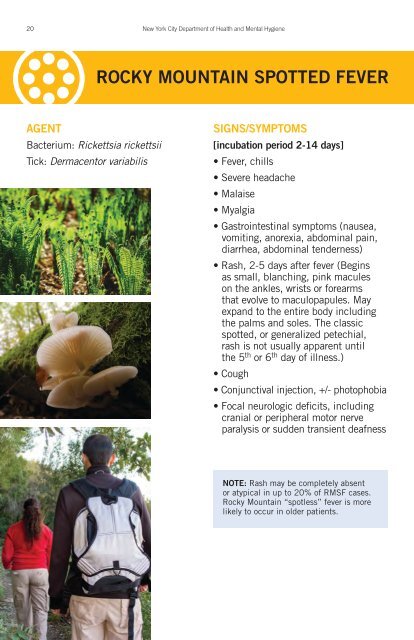tick-borne-dx-physician
tick-borne-dx-physician
tick-borne-dx-physician
You also want an ePaper? Increase the reach of your titles
YUMPU automatically turns print PDFs into web optimized ePapers that Google loves.
20 New York City Department of Health and Mental Hygiene<br />
ROCKY MOUNTAIN SPOTTED FEVER<br />
AGENT<br />
Bacterium: Rickettsia rickettsii<br />
Tick: Dermacentor variabilis<br />
SIGNS/SYMPTOMS<br />
[incubation period 2-14 days]<br />
• Fever, chills<br />
• Severe headache<br />
• Malaise<br />
• Myalgia<br />
• Gastrointestinal symptoms (nausea,<br />
vomiting, anorexia, abdominal pain,<br />
diarrhea, abdominal tenderness)<br />
• Rash, 2-5 days after fever (Begins<br />
as small, blanching, pink macules<br />
on the ankles, wrists or forearms<br />
that evolve to maculopapules. May<br />
expand to the entire body including<br />
the palms and soles. The classic<br />
spotted, or generalized petechial,<br />
rash is not usually apparent until<br />
the 5 th or 6 th day of illness.)<br />
• Cough<br />
• Conjunctival injection, +/- photophobia<br />
• Focal neurologic deficits, including<br />
cranial or peripheral motor nerve<br />
paralysis or sudden transient deafness<br />
NOTE: Rash may be completely absent<br />
or atypical in up to 20% of RMSF cases.<br />
Rocky Mountain “spotless” fever is more<br />
likely to occur in older patients.



